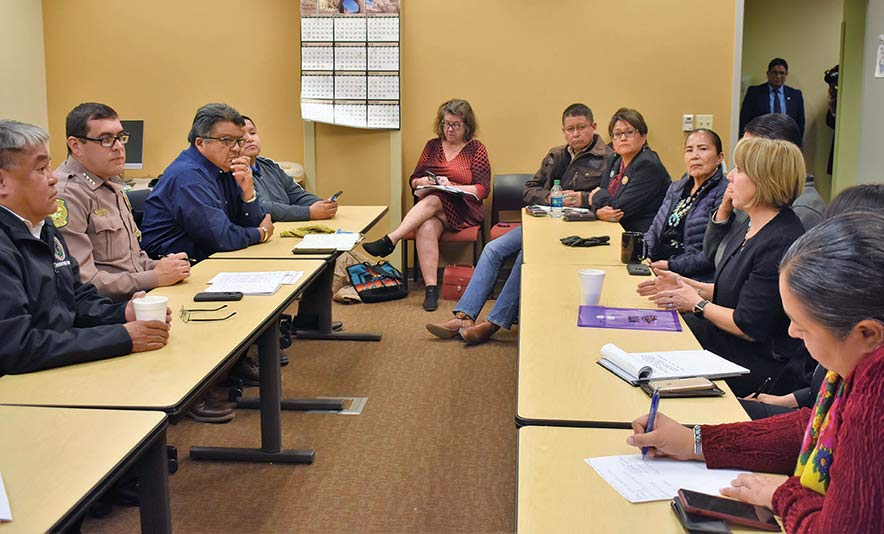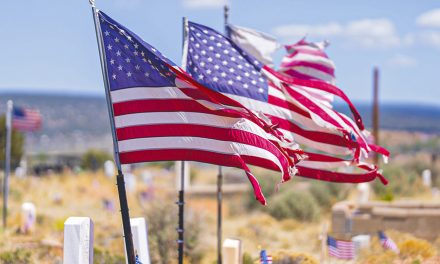
‘New Mexico will step up”: NM governor committed to investing in Navajo

NAVAJO TIMES | RIMA KRISST
Navajo Nation leaders and public safety and law enforcement officials Director Jesse Delmar and Chief of Police Philip Francisco, left, consult with Gov. Michelle Lujan Grisham, right, on issues at the Crownpoint Justice Center.
CHURCH ROCK, N.M.
The leaders of the three branches of the Navajo Nation government rolled out the red carpet for New Mexico Gov. Michelle Lujan Grisham and her staff on Monday with an effort that highlighted the importance of positive state-tribal relations.
“I’m very grateful to the Navajo Nation for inviting me for today and I hope this will be one of many days where we think about ways to improve quality of life for everyone here on Navajo,” said the governor.
Grisham, who told President Jonathan Nez she is not really a runner, nevertheless kept the pace for a marathon itinerary that comprised an 11-hour day of meetings, presentations and chapter visits.
Speaker Seth Damon, Chief Justice JoAnn B. Jayne and several Navajo Nation Council delegates participated.
“I appreciate her willingness to come and break bread with the Navajo Nation people as well as to visit our nation,” said Nez at a District 6 luncheon at Fire Rock Casino.
By the end of the day, no firm agreements were made except for Grisham’s strong commitment to listening to the needs of the people, the priorities of leadership and continuing to make “robust” state investments to benefit Navajo.
“What I committed to the Navajo Nation and every single sovereign nation is that they will continue to be a top priority,” said Grisham.
The main topics that were addressed were shortcomings in health-care services, elder and child care, education, economic development, broadband internet and cellular coverage, infrastructure, including roads and water development, and public safety.
“Our governor has done several things to elevate relationship between New Mexico and our tribal nations,” said Indian Affairs Department Cabinet Secretary Lynn Trujillo, who encouraged Navajo communities to invite them to visit.
Grisham said that one of her favorite parts of the day was when she saw some Navajo elders she used to work with when she was head of the New Mexico Aging and Long-Term Services Department.
“I got to reconnect with some seniors who I haven’t seen in over a decade who remember our work,” said Grisham. “It was incredible. It really made my day.”
Envisioning business expansion
At the Church Rock Business Incubator, the group toured the neighboring Rhino Health medical glove factory that was built by an all-Navajo crew and now employs 35 Navajo workers.
The project recently had another $19 million approved by the Council to launch “phase two” – a warehouse factory that will create over 300 jobs.
“It’s huge, it’s monumental,” said Grisham.
“There’s no question that if you have a vision, good partners and good leaders that any number of things can happen,” she said.
She said that in the past year $75 million was invested in local economic development statewide and there was an increase in job training funding as well.
Mark Lee, president and CEO of Rhino Health glove manufacturer, said that his vision aims to nurture the local economy and bring opportunities to the Navajo people.
For example, the company plans to hire 10 interns per year from Navajo Technical University to encourage an education-to-workforce pipeline.
Lee’s goal is to achieve 5 percent of the U.S. medical glove market share, or about 5 billion gloves per year, as the first “made in the U.S.A. glove manufacturer empowered by Navajo Nation production.”
“For far too long we’ve lost our jobs and our young people to jobs and careers out of state,” said Grisham. “With these kinds of priorities we will be shipping out goods and services and keeping our young people and Navajo families together right here with endless opportunities.”
Navajo Area Indian Health Service Director Roselyn Tso said that while the new Gallup Indian Medical Center project is still in the planning stages, it could triple the number of beds in the existing hospital (87), built in 1961, and would include a Level 4 trauma center and referral center.
Tso said that for 2019 they were approaching 11,000 inpatient visits, 400 births, 400,000 outpatient visits, and 37,000 emergency visits. GMIC has exceeded its maximum capacity, she said, and cannot be upgraded to modern medical standards.
She said there are approximately 4,000 federal employees and 2,000 contract providers in the Navajo Area IHS but there is an extreme shortage of nursing staff. Recruitment is their biggest challenge.
“It’s a national problem,” said Grisham, who added there needs to be additional planning for educating nurses on the fast track.
‘We won’t abandon the Nation’
Jill Jim, director of the Navajo Nation’s Department of Health, said there is a shortage of behavioral and mental health professionals as well as detox and treatment centers, and high suicide rates.
She stressed the importance of culturally appropriate services and Diné way of life teachings in all aspects of health care and planning.
Nez said the Navajo Wellness Model should be incorporated as part of upholding sovereignty, self-governance, and self-determination.
Jim spoke to the decline in funding for elder services as well, including senior centers.
Grisham confirmed her administration is looking to focus on elder care and services again.
She said Navajo used to be a “shining example” of the kind of investments the state can make.
During the last eight years the state stopped investing in senior programs and group homes on the Navajo Nation or anywhere else, she said.
“It’s a terrible lesson to be learned that when the state didn’t have any resources they took that out on senior programs, which I find unacceptable,” said Grisham. “We want to make sure that we turn that around. You should consider us full partners and we won’t abandon the Nation again.”
Grisham also plans to establish a $25 million elder trust fund “so that we have the opportunities for infusion of service dollars.”
“Adult day care or adult day health are incredible models that would be very successful,” she said. “We’d like to see more of that on the Navajo Nation.”
Jim said that the Nez-Myron Lizer “War on Diabetes” initiative that encourages healthy lifestyles and prevention stems from the fact that the preventable disease is the fourth leading cause of death on the Nation.
Grisham mentioned that the U.S. spends $450 billion annually on diabetes-related health costs.
“If we had access to just that money, we could reform the entire health care system,” she said. “Diabetes is a destructive, heinous disease that we have the power to change.”
Finally Grisham said that people with drug or alcohol additions are entitled to get the proper services they deserve.
“We need to make sure that instead of being incarcerated they get into appropriate detox and behavioral and mental health services using Navajo teachings and culture,” she said.
Grisham said the prior administration cancelled every single behavioral health Medicaid contract and the state is having to settle lawsuits from providers and patients whose lives were destroyed and begin to “rebuild the system” again.
Natural resources
Jason Johns, director of the Navajo Nation’s Water Management Branch, said there are challenges to water development and progress is being made in partnership with IHS, Navajo Tribal Utility Authority, state and federal funding.
More than an estimated third of Navajo Nation residents still don’t have access to potable water.
“We want to fix it for the entire Navajo Nation,” said Grisham. “We want to support you and private enterprises to do exactly that.”
Johns said New Mexico has been supporting Navajo water development for years and the governor’s visit reinforces that commitment.
Grisham said that developing water infrastructure is incredibly time consuming and expensive and everyone needs to work together to come up with innovative solutions.
She also highlighted the shift to renewable energy and energy-saving measures.
“Highlighting partnerships to get into renewable and green energy and reducing carbon footprint is a priority,” she said. “New Mexico is now a leader in that area but there is still more work to be done.”
Equity in education
In a visit to Navajo Technical University in Crownpoint, Grisham said she is firmly behind fulfilling obligations to Native American students from Head Start through higher education.
She said two of her main priorities are childcare services and early childhood education.
“We should be able to show that with every single one of our state’s dollars our priority is our future and our children,” said Grisham.
She added that the last legislative session yielded one of the largest teacher salary increases (4 percent) in an appropriation of $448 million.
“What we need is stability for our educators,” she said.
Grisham also wants to make college tuition free for an estimated 55,000 New Mexicans who would be eligible.
NTU President Elmer Guy and Vice President of Operations Jason Arviso said the institution has benefited from state capital projects funds and they are seeking additional funding.
They wish to start a “Cultural Curriculum Center” in partnership with the Pueblos, where language and culture educational materials, including books and methodologies, could be developed for K-12.
They are promoting this project and others that could go toward fulfilling some of the obligations of last year’s Yazzie-Martinez v. State of New Mexico settlement (2018), said Guy.
Delegate Amber Kanazbah Crotty said the Navajo Nation has never received funding to implement the Yazzie-Martinez settlement despite the fact that the core clients in the case were Navajo families.
“The state has failed with educational obligation to Native American students for a long time,” said Grisham. “It’s going to take us a while to catch up, but know that we are committed. We will continue to ask for resources.”
Finally, NTU wants to bring high-speed internet connections into the area that would help communications with other higher learning institutions and online curriculums.
Guy said they hope to find a way to “run fiber” from Interstate 40 to NTU to that end.
‘Doing nothing is unacceptable’
In the final stop for the day at the Crownpoint Justice Center, Grisham heard from Navajo Nation Division of Public Safety Director Jesse Delmar, Chief of Police Philip Francisco, and Telecommunications Regulatory Commission Director Christopher Becenti.
They emphasized the need for rural addressing, E-911 dispatch services, and improved broadband internet and cellular service.
They also said issues need to be resolved with cross-commissioning of officers, including inadequate funding and insurance coverage to cover liability while working in other districts.
“I’m ready and willing to accept the challenge that we have to work with the sheriffs and first responders to help solve this problem,” said Grisham. “Doing nothing is unacceptable.”
Jurisdictional issues between, state, county and tribal police and emergency services coverage often leaves tribal communities at a severe disadvantage, they said, and Navajo police officers out on a limb if they find themselves serving in a law enforcement capacity off-reservation.
Grisham emphasized that crime prevention, data sharing, communications, the regulatory environment, adequate cell coverage, and comprehensive emergency response are issues that plague many New Mexico communities.
“I think there might be a multitude of ways for us to be better partners,” said Grisham. “We have an opportunity using the state’s platform. We should not be abandoning our responsibility to the Navajo Nation.”








 Highway 264,
Highway 264, I-40, WB @ Winslow
I-40, WB @ Winslow